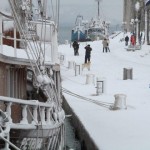Some proper snow in Trogir, after many years 🙂
No Title
2012
No Title
2012
Some proper snow in Trogir, after many years 🙂
No Title
2012
No Title
2012
No Title
2011
From Home to home, and heart to heart, from one place to another. The warmth and joy of Christmas, brings us closer to each other.
Stormy december night in Trogir
2011
Trogir, which is otherwise known for its beauty and heritage looked even more beautiful. Slightly rough seas and wild skies are responsible for this romantic and beautiful pictures.


Within the 15th action “Tourist flower – Quality for Croatia 2011.” conducted by the Ministry of Tourism, Croatian Television, Croatian Economic Chamber and Croatian National Tourist Board on October 20th, in the presence of a large number of travel agents and government officials in Šibenik , the winners of 2nd and 3rd prizes in category of hotels, marinas, camping sites and tourist destinations were declared. Co organizers of the action: the Ministry of Environmental Protection, Physical Planning and Construction, Association of Employers in the Croatian hotels, the Croatian Automobile Club, the Institute for Social Research “Ivo Pilar” and the system of tourist boards.
Category: Best tourist resorts on the Adriatic coast with up to 5,000 beds
Second place – City of Split
Third place – City of Trogir
Historic city of Trogir (UNESCO)
2011
Trogir is an excellent example of a medieval town built on and conforming with the layout of a Hellenistic and Roman city that has conserved its urban fabric to an exceptional degree and with the minimum of modern interventions, in which the trajectory of social and cultural development is clearly visible in every aspect of the townscape.
Trogir is a remarkable example of urban continuity. The orthogonal street plan of this island settlement dates back to the Hellenistic period and it was embellished by successive rulers with many fine public and domestic buildings and fortifications. Its beautiful Romanesque churches are complemented by the outstanding Renaissance and Baroque buildings from the Venetian period.
The ancient town of Tragurion (island of goats) was founded as a trading settlement by Greek colonists from the island of Vis in the 3rd century BC on an islet at the western end of the bay of Manios, in a strait between the mainland and one of the Adriatic islands, where there was already a small settlement. The Hellenistic town was enclosed by megalithic walls and its streets were laid out on a Hippodamian grid plan: the line of the ancient cardo maximus is that of the modern main street. The town flourished in the Roman period as an oppidum civium romanorum ; during the late Roman period it was extended and refortified. Extensive Roman cemeteries have been discovered, and a basilica was erected in one of these.
Although it was not made a bishopric in the early Christian period, Trogir was endowed with two large aisled basilicas, sited where the latter-day Cathedral and Benedictine Church of St John the Baptist now stand. In the second half of the 9th century, Trogir became part of the Byzantine theme of Dalmatia, with its capital at Zadar, and it was occupied by Venice at the end of the 10th century. Early medieval Trogir expanded to the south and new fortifications were constructed. At the beginning of the 12th century, Trogir accepted Hungarian rule when the theme of Dalmatia was overrun. There was a short period of Venetian rule in the early 14th century, but it was not until 1420 that the town became part of the Venetian empire. Between the 13th and 15th centuries much new building took place, this period seeing the construction of the cathedral and the Camerlengo fortress, a radical remodelling of the main square, and two campaigns of reconstruction and strengthening of the fortifications. The Treaty of Campo Formio (1797) handed Trogir over to the Austro-Hungarian Empire, to which it belonged, apart from a short period under French rule, as part of the Illyrian provinces until 1918.
The plan of contemporary Trogir reflects the Hellenistic layout in the location, dimensions, and shapes of its residential blocks. The two ancient main streets, the cardo and the decumanus, are still in use, and paving of the forum has been located by excavation at their intersection. Ancient Tragurion lies at the eastern end of the islet; this spread out in the earlier medieval period. The medieval suburb of Pasike developed to the west on a different alignment, and was enclosed by the later fortifications. The port was located on the south side. Finally, the massive Venetian fortifications incorporated the Genoese fortress known as the Camerlengo. Construction of the Cathedral of St Lawrence, built on the site of an earlier basilica and dominating the main square, began around 1200 and was added in the late 16th century. This relatively protracted period of construction has meant that successive architectural styles – Romanesque, Gothic and Renaissance – are all represented. It is a three-aisled basilica, each of the aisles terminating in an apse. Inside the porch at the west end is the baptistry. Of the numerous aristocratic palaces the Cipico Palace, facing the west end of the cathedral, is the most outstanding: it consists of a complex of structures covering an entire town block. Most of it dates back to the 13th century, but some elements of buildings from the late Roman period are incorporated in it. During the 15th century the owner brought in the three most celebrated artists of the period to embellish its facade and interior. Throughout the town, and in particular round the ramparts, are the palaces of other leading families. Many of these rise directly from the foundations of late classical or Romanesque structures and are in all styles from Gothic to Baroque.
Source: UNESCO/CLT/WHC
New Photo gallery!
2011














